
The straight-six engine is a piston engine with six cylinders arranged in a straight line along the crankshaft. A straight-six engine has perfect primary and secondary engine balance, resulting in fewer vibrations than other designs of six or less cylinders.
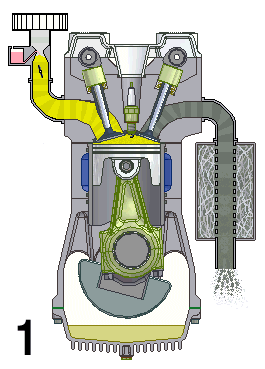
A naturally aspirated engine, also known as a normally aspirated engine, and abbreviated to N/A or NA, is an internal combustion engine in which air intake depends solely on atmospheric pressure and does not have forced induction through a turbocharger or a supercharger.

The BMW 5 Series is an executive car manufactured and marketed by BMW since 1972, succeeding the New Class Sedans, and currently in its seventh generation.

The BMW E23 is the first generation of the BMW 7 Series luxury cars and was produced from 1977 until 1986. It was built in a 4-door sedan body style with 6-cylinder engines, to replace the BMW 'New Six' (E3) sedans. From 1983 until 1986, a turbocharged 6-cylinder engine was available.

The BMW E28 is the second generation of BMW 5 Series executive cars, which was produced from 1981 to 1988 and replaced the E12 5 Series. Pre-series production began in April 1981 and the car was introduced in the autumn that year.
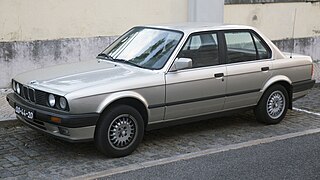
The BMW E30 is the second generation of BMW 3 Series, which was produced from 1982 to 1994 and replaced the E21 3 Series. The model range included 2-door coupe and convertible body styles, as well as being the first 3 Series to be produced in 4-door sedan and wagon/estate body styles. It was powered by four-cylinder petrol, six-cylinder petrol and six-cylinder diesel engines, the latter a first for the 3 Series. The E30 325iX model was the first BMW to have all-wheel drive.

Mazda has a long history of building its own diesel engines, with the exception of a few units that were built under license.

The Mitsubishi Sirius or 4G6/4D6 engine is the name of one of Mitsubishi Motors' four series of inline-four automobile engines, along with Astron, Orion, and Saturn.
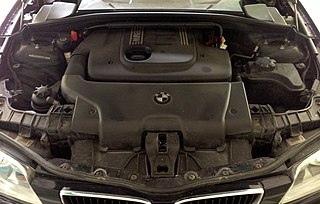
The BMW M47 and Rover Group M47R are straight-4 Diesel engines. Variants were manufactured by BMW from 1998 to 2007. BMW gradually adopted high-pressure common rail fuel injection systems over the lifetime of the M47.
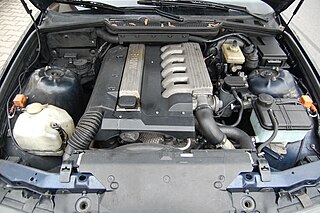
The BMW M51 is an inline-6 cylinder Diesel engine produced by the Upper Austrian BMW plant in Steyr from July 1991 through February 2000. Its predecessor is the BMW M21, the successor is the BMW M57.

The BMW M57 is a straight-6 diesel engine produced from 1998 up to 2013 in BMW's upper Austrian engine plant in Steyr.

The term turbo-diesel, also written as turbodiesel and turbo diesel, refers to any diesel engine equipped with a turbocharger. As with other engine types, turbocharging a diesel engine can significantly increase its efficiency and power output, especially when used in combination with an intercooler.
The L-series engine is an automotive diesel engine built by Powertrain Ltd, a sister company of MG Rover.

Engines used by the British company Land Rover in its 4×4 vehicles have included four-cylinder petrol engines, and four- and five-cylinder diesel engines. Straight-six cylinder engines have been used for Land Rover vehicles built under licence. Land Rover has also used various four-cylinder, V8, and V6 engines developed by other companies, but this article deals only with engines developed specifically for Land Rover vehicles.

The BMW 1 Series is a range of subcompact executive cars (C-segment) manufactured by BMW since 2004. It is the successor to the BMW 3 Series Compact and is currently in its third generation. Positioned as the entry level model in BMW range of products, the first generation was produced in hatchback, coupé and convertible body styles.
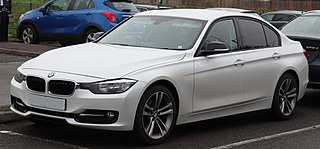
The sixth generation of the BMW 3 Series consists of the BMW F30, BMW F31 and BMW F34 compact executive cars. The F30/F31/F34 generation was produced from October 2011 to 2019 and is often collectively referred to as the F30.
Turbochargers have been used on various petrol engines since 1962, in order to obtain greater power or torque output for a given engine displacement.

Alfa Romeo has made three 8-cylinder Grand Prix racing engines designed for both Formula One and sports car racing; in both inline and V engine configurations. Their first was the supercharged 158/159, a straight-eight engine, with the 1.5 L engine configuration imposed by the FIA for forced induction engines, in 1950. After a 20-year gap, their second engine was the Tipo 33 engine, a 3-liter naturally-aspirated V8 engine, in 1970. Their third and final engine was the turbocharged 890T V8 engine in 1983, which was used by both Alfa Romeo until 1985, and Osella until 1988, until Alfa Romeo eventually pulled out of F1 that same year.
















